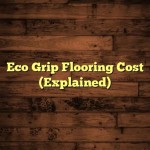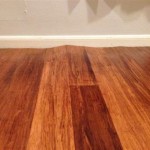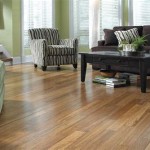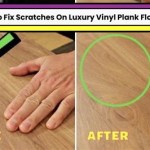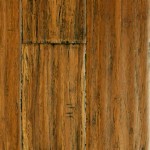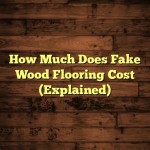Laying Vapor Barrier for Laminate Flooring: A Comprehensive Guide
Laminate flooring represents a popular choice for residential and commercial spaces due to its durability, aesthetic appeal, and relatively straightforward installation process. However, a critical step often overlooked during laminate flooring installation is the implementation of a proper vapor barrier. A vapor barrier, also known as a moisture barrier, plays a crucial role in protecting the laminate flooring from moisture damage originating from the subfloor. Understanding the purpose, selection, and installation of a vapor barrier is essential for ensuring the longevity and performance of the laminate flooring.
This article provides a comprehensive guide to laying a vapor barrier for laminate flooring, covering the essential aspects to consider before, during, and after the installation process. It delves into the reasons why a vapor barrier is necessary, the types of vapor barriers available, the steps involved in installation, and potential problems that can arise during the process.
The Necessity of a Vapor Barrier
Moisture is a significant threat to laminate flooring. Subfloors, particularly concrete slabs, can emit moisture vapor over time. This moisture can permeate the laminate flooring from below, causing several problems that can compromise the flooring's structural integrity and appearance. Some of these problems include:
Warping and Buckling: Laminate flooring boards can absorb moisture, causing them to expand. When boards expand against each other, they can warp or buckle, leading to an uneven surface and potential tripping hazards.
Mold and Mildew Growth: Moisture trapped beneath the laminate flooring creates a conducive environment for mold and mildew growth. These organic growths can release unpleasant odors and pose health risks, particularly for individuals with allergies or respiratory issues.
Delamination: Laminate flooring consists of several layers bonded together. Excessive moisture can weaken the adhesive between these layers, leading to delamination, where the layers separate and the flooring surface deteriorates.
Reduced Lifespan: Prolonged exposure to moisture significantly reduces the lifespan of laminate flooring. The flooring may require premature replacement, leading to additional expenses and inconvenience.
A vapor barrier mitigates these risks by preventing moisture from migrating from the subfloor to the laminate flooring. It acts as a protective shield, maintaining a relatively dry environment beneath the flooring and preserving its integrity.
Types of Vapor Barriers for Laminate Flooring
Several types of vapor barriers are available for laminate flooring installation, each offering varying levels of moisture protection and suitability for different subfloor conditions. The selection of the appropriate vapor barrier depends on factors such as the type of subfloor (concrete or wood), the level of moisture present, and the specific requirements of the laminate flooring manufacturer.
Polyethylene Film: Polyethylene film is a common and cost-effective vapor barrier option. It consists of a thin plastic sheet that is laid over the subfloor to block moisture. Polyethylene film is typically available in thicknesses ranging from 3 to 6 mils (thousandths of an inch). A thicker film provides better moisture protection but can be more difficult to handle during installation.
Attached Underlayment with Vapor Barrier: Some laminate flooring products come with an attached underlayment that includes an integrated vapor barrier. This option simplifies the installation process as it eliminates the need for a separate vapor barrier. However, it is essential to ensure that the attached underlayment provides adequate moisture protection for the specific subfloor conditions.
Foil-Faced Vapor Barrier: Foil-faced vapor barriers consist of a layer of aluminum foil bonded to a polyethylene or other plastic backing. The foil provides excellent moisture resistance and can also reflect heat, improving the energy efficiency of the flooring system. Foil-faced vapor barriers are often used in areas with high moisture levels or where radiant heating systems are installed.
Specialized Vapor Barriers: For subfloors with particularly high moisture levels, specialized vapor barriers may be required. These barriers often feature advanced moisture-blocking technologies and may require professional installation. Examples include liquid-applied vapor barriers and self-adhesive membranes.
It is crucial to consult the laminate flooring manufacturer's recommendations regarding the appropriate type and thickness of vapor barrier to use with their products. Using an inadequate or incompatible vapor barrier can void the warranty and compromise the flooring's performance.
Installation Process of a Vapor Barrier
Proper installation of the vapor barrier is essential to ensure its effectiveness. The installation process typically involves the following steps:
Subfloor Preparation: Before installing the vapor barrier, the subfloor must be thoroughly cleaned and prepared. Remove any debris, dust, nails, or staples that could puncture the vapor barrier. Ensure that the subfloor is level and free of any significant imperfections. If the subfloor is uneven, it may need to be leveled with a self-leveling compound.
Cutting the Vapor Barrier: Measure the dimensions of the room and cut the vapor barrier material to size, allowing for overlap at the seams. It is generally recommended to overlap the seams by at least 6 inches to ensure a continuous moisture barrier.
Laying the Vapor Barrier: Begin laying the vapor barrier material over the subfloor, starting at one corner of the room. Ensure that the vapor barrier is flat and smooth, without any wrinkles or folds. Overlap the seams as specified and secure them with moisture-resistant tape. The tape should be specifically designed for sealing vapor barrier seams and should provide a strong and durable bond.
Taping the Seams: Carefully tape all seams and around the perimeter of the room where the vapor barrier meets the walls. This creates a continuous seal and prevents moisture from infiltrating the flooring system. Use a roller to apply pressure to the tape, ensuring a firm bond with the vapor barrier material.
Inspecting the Installation: After installing the vapor barrier, inspect it carefully for any punctures, tears, or gaps. Repair any imperfections with tape to maintain the integrity of the moisture barrier.
Laying the Underlayment (if separate): If the chosen laminate flooring requires a separate underlayment, install it over the vapor barrier according to the manufacturer's instructions. The underlayment provides cushioning and sound insulation, enhancing the comfort and performance of the flooring.
Installing the Laminate Flooring: Once the vapor barrier and underlayment (if applicable) are installed, proceed with the installation of the laminate flooring according to the manufacturer's instructions. Ensure that the flooring is properly acclimated to the room's temperature and humidity before installation.
Potential Problems and Solutions
Despite careful planning and execution, certain problems can arise during the vapor barrier installation process. Being aware of these potential issues and their solutions can help ensure a successful outcome.
Tears and Punctures: The vapor barrier can be easily torn or punctured during installation, particularly if the subfloor is not properly prepared. To prevent tears, handle the vapor barrier material with care and ensure that the subfloor is free of sharp objects. If a tear or puncture occurs, repair it immediately with moisture-resistant tape.
Inadequate Overlap: Failure to overlap the seams of the vapor barrier adequately can compromise its effectiveness. Ensure that the seams are overlapped by at least 6 inches and securely taped to create a continuous moisture barrier.
Improper Taping: Using the wrong type of tape or failing to apply it properly can result in a weak seal at the seams. Use moisture-resistant tape specifically designed for sealing vapor barrier seams and apply it firmly to ensure a strong bond.
Moisture Trapped Beneath the Vapor Barrier: If moisture is present on the subfloor before the vapor barrier is installed, it can become trapped beneath the barrier and lead to mold growth. Ensure that the subfloor is dry before installing the vapor barrier. If necessary, use a dehumidifier to remove excess moisture from the room.
Condensation: In certain climates, condensation can form on the underside of the vapor barrier. This can occur if the temperature difference between the subfloor and the room is significant. To prevent condensation, ensure that the room is properly ventilated and that the subfloor is adequately insulated.
Incompatible Materials: Using a vapor barrier that is incompatible with the laminate flooring can lead to problems. Always consult the laminate flooring manufacturer's recommendations regarding the appropriate type of vapor barrier to use.
Addressing these potential problems proactively can help ensure the long-term performance and durability of the laminate flooring.

What Is A Moisture Barrier And When It Needed For Flooring Inc

Vapor Barrier Under Laminate Floor And Floating Problems

How To Install The Moisture Barrier Over Concrete Subfloor

How To Lay Underlayment For Laminate Flooring

Silent Silver Underlayment High Density Foam Underlay

Ask The Contractor Things You Didn T Know About Floor Underlayment Forbes Home

Hardwood Floor Underlayment Ultimate Guide

Does The Quiet Walk Underlayment Plastic Vapor Barrier Face Up Or Down When Installing Mp Global S Llc

How To Install A Vapor Barrier Below Laminate Flooring Working On

Quietwalk 100 Sq Ft X 3 33 34 1 4mm Acoustical Underlayment With Vapor Barrier For All Vinyl Plank Flooring Qwlv100 The Home Depot
Related Posts


